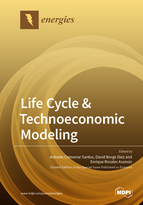Life Cycle & Technoeconomic Modeling
A special issue of Energies (ISSN 1996-1073). This special issue belongs to the section "B: Energy and Environment".
Deadline for manuscript submissions: closed (30 June 2020) | Viewed by 39623
Special Issue Editors
Interests: energy efficiency; energy economics; renewable energy; energy simulation; energy optimization
Special Issues, Collections and Topics in MDPI journals
Interests: energy efficiency; energy economics; renewable energy; energy simulation; energy optimization
Special Issues, Collections and Topics in MDPI journals
Interests: environment management systems; water desalination; waste-heat-recovery technology; electrical engineering
Special Issues, Collections and Topics in MDPI journals
Special Issue Information
Dear Colleagues,
This Special Issue aims to perform an impartial analysis to evaluate the implications of the environmental costs and impacts of a wide range of technologies and energy strategies. This information is intended to be used to support decision-making by groups, including researchers, industry, regulators, and policy-makers. Life cycle assessment (LCA) and techno-economic analysis can be applied to a wide variety of technologies and energy strategies, both established and emerging. LCA is a method used to evaluate the possible environmental impacts of a product, material, process, or activity. It assesses the environmental impact throughout the life cycle of a system, from the acquisition of materials to the manufacture, use, and final disposal of a product. Techno-economic analysis refers to cost evaluations, including production cost and life-cycle cost. Often, in order to carry out a techno-economic analysis, researchers are required to obtain data on the performance of new technologies that operate on a very small scale in order to subsequently design configurations on a commercial scale and estimate the costs of such expansions. The results of the developed models help identify possible market applications and provide an estimate of long-term impacts. These methods, together with other forms of decision analysis, are very useful in the development and improvement of energy objectives, since they will serve to compare different decisions, evaluating their political and economic feasibility and providing guidance on potential financial and technological risks.
Prof. Dr. Antonio Colmenar-Santos
Prof. Dr. David Borge Diez
Dr. Enrique Rosales Asensio
Guest Editors
Manuscript Submission Information
Manuscripts should be submitted online at www.mdpi.com by registering and logging in to this website. Once you are registered, click here to go to the submission form. Manuscripts can be submitted until the deadline. All submissions that pass pre-check are peer-reviewed. Accepted papers will be published continuously in the journal (as soon as accepted) and will be listed together on the special issue website. Research articles, review articles as well as short communications are invited. For planned papers, a title and short abstract (about 100 words) can be sent to the Editorial Office for announcement on this website.
Submitted manuscripts should not have been published previously, nor be under consideration for publication elsewhere (except conference proceedings papers). All manuscripts are thoroughly refereed through a single-blind peer-review process. A guide for authors and other relevant information for submission of manuscripts is available on the Instructions for Authors page. Energies is an international peer-reviewed open access semimonthly journal published by MDPI.
Please visit the Instructions for Authors page before submitting a manuscript. The Article Processing Charge (APC) for publication in this open access journal is 2600 CHF (Swiss Francs). Submitted papers should be well formatted and use good English. Authors may use MDPI's English editing service prior to publication or during author revisions.
Keywords
- life cycle
- technoeconomic modeling
- energy strategies







